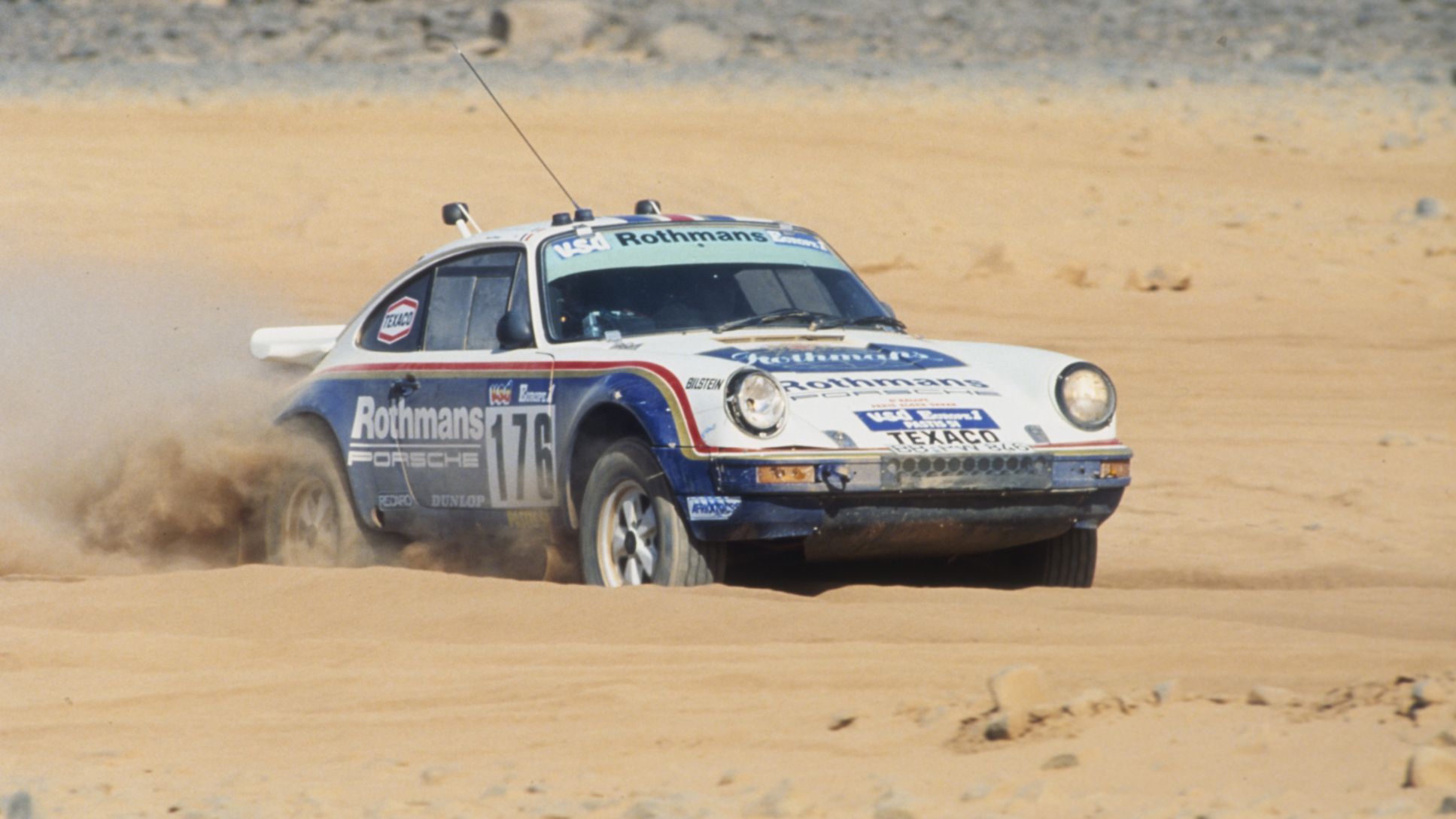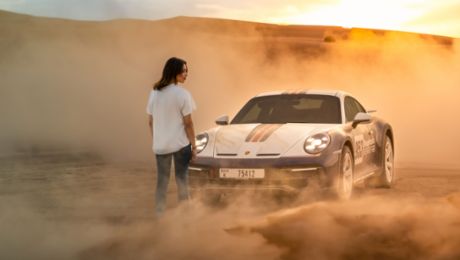With more than 30,000 individual wins, Porsche is one of the most successful brands in motorsport history. And rally cars have repeatedly added to that number. Way back in January 1965, just four months after it went on sale, the Porsche 911 entered the Rallye Monte Carlo and took fifth place. Three years later, Vic Elford recorded the first 911 win in Monaco, with the Englishman driving a 911 SC 2.0. In 1969 and 1970, the Swede Björn Waldegård repeated the feat. And in each of those years, another rally-spec 911 took second place in the Rallye Monte Carlo.
The World Rally Championship as we know it today was first held in 1973, while there has been a title for the most successful driver since 1979. Porsche has never competed in the overall championship, but has taken part in individual races. In the 1970s, Porsche also entered the 911 in East African Safari Rallye, a race through Kenya across roughly 5,000 km that was part of the World Rally Championship (though Porsche was not challenging for this). A Porsche 911 took fifth in 1971, and a 911 came in second place in both in 1974 and 1978.
Group B paves the way
In 1981, Walter Röhrl, the previous year’s champion, joined Porsche for a single season and drove the 924 Carrera GTS in the German Rally Championship. In the World Rally Championship, he raced only the Rally San Remo in the 911 SC.
Porsche, meanwhile, was gathering its forces for a new concept: In 1982, the FIA – the world motorsport federation –introduced Group B regulations for extremely powerful GT cars that could also be used in the World Rally Championship. In 1983, the first concept study of the future super sports car – the 959 – was exhibited at the IAA in Frankfurt. It bore the telling model name ‘Gruppe B’. The 959 would be the first series-production Porsche with all-wheel drive, but the development of this new drive concept had begun in the early 1980s with the 911. At the IAA in 1981, Porsche had unveiled a concept car that united the highlights of the Cabriolet, Turbo and all-wheel drive. Its name: The Porsche 911 Turbo 3.3 4x4 Cabriolet.
This prototype was later extensively tested by Walter Röhrl, among others. And when Jacky Ickx, the four-time Le Mans-winner in a Porsche, saw the prototype being driven in Weissach, he had an idea: He wanted to enter the Paris-Dakar with a rally 911 and all-wheel drive. This 11,000 km extreme rally, which was held outside the auspices of the World Rally Championship, had been gaining in renown year by year since 1979, and Ickx had already won it in 1983 with a Mercedes 280 GE.
Internal name of the Dakar 911: 953
Ickx’s idea meant the chance for a successful pioneering programme for Porsche. Head of Development Helmuth Bott gave his assent, Ickx got the cigarette brand Rothmans to agree to sponsor the Paris-Dakar entry, and three Porsche 911 Carrera 3.2 cars with all-wheel drive and numerous rally upgrades were fitted out for the race. Official type designation: Porsche 911 Carrera 3.2 4x4 Paris-Dakar. Internally, the car was known simply as the 953.
Alongside Ickx and co-driver Claude Brasseur, the Frenchman René Metge, Dakar winner in a Range Rover in 1981, with his co-driver Dominique Lemoyne, plus Porsche project manager Roland Kussmaul and co-driver Erich Lerner, also joined the driver crew ranks. Ickx and Metge were to drive for a result, and victory if possible, while the Kussmaul/Lerner team were deployed as a rolling testbed. There was also a mechanic crew in the truck classification on hand to support the three 911s.
The established competition with their all-terrain vehicles didn’t take the Porsche foray seriously at first, but they would soon know better. While the 911 Carrera 4x4 driven by Jacky Ickx had a breakdown on the first day in the desert due to a rock impact and the repairs took hours, René Metge lived up to his reputation as a virtuoso desert driver and cruised the sand and gravel at speeds of 150 km/h and more. The rally 911 was several hundred kilograms lighter than the big all-terrain vehicles, while the boxer engine delivered 165 kW (225 PS) – two winning feathers in the Porsche cap. The big traction advantage of the rear engine was a boon in every rally, and the Paris-Dakar was no exception. And when tackling big dunes with lots of soft sand, the teams could actuate a lever in the centre console to lock the differential between the rear and front axles – creating a jolting driving experience in the 911 Carrera 4x4, but with maximum traction.
First place for the complete Porsche team
In the end, Metge took overall victory. Ickx doggedly moved up from 139th place to take sixth, while Roland Kussmaul came in an impressive 26th – securing first place in the team classification.
After this massive success, Porsche entered the Paris-Dakar again the following year, this time with the first 959. According to the Group B rules, at least 200 series-production cars had to be sold for homologation – a condition Porsche had fulfilled with confirmed orders shortly after the IAA in 1983. Porsche therefore entered a rally with the precursor of a Group B car for the first time. Alas, the 400 PS biturbo engines were not finished in time. So, in 1985, it was not three 911s with 959 components at the start as in the year before, but three 959 cars with 911 engines. Due to the vagaries of the Paris-Dakar, none managed to make it to the finish line, so they tried again the next year – and won. Again it was René Metge/Dominique Lemoyne who secured the victory for Porsche. Ickx/Brasseur took second on this occasion, while Kussmaul and his co-driver took sixth.
After this triumph, Porsche ended its run at the Paris-Dakar. The 959 would ultimately not appear in the World Rally Championship either, as the FIA banned the use of Group B cars in the competition at the end of 1986. The highly refined cars had proved too dangerous and were only allowed to drive in the European Rallycross Championship. Porsche was not interested.
Five years after the first triumph came the 911 Carrera 4
What remained as the legacy of the Paris-Dakar races was the road-legal 959 as the most powerful Porsche production model to date at the time: with 336 kW (450 PS), the 959 easily surpassed both the 911 Turbo and the eight-cylinder 928 in the late 1980s. Another even more important benefit was that although just 292 examples were built, the 959 was the first series-production Porsche with all-wheel drive. The G-series 911, on which the 911 Carrera 4x4 for Paris-Dakar was based, remained on sale until 1988 and did not feature all-wheel drive. However, with the launch of the third 911 generation – the 964 – the time had come: before 1988 was out, and even though it was designated as a 1989 model year car, a Porsche 911 Carrera 4 was launched.


